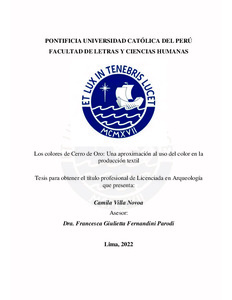| dc.contributor.advisor | Fernandini Parodi, Francesca Giulietta | |
| dc.contributor.author | Villa Novoa, Camila | |
| dc.date.accessioned | 2022-12-07T18:07:34Z | |
| dc.date.available | 2022-12-07T18:07:34Z | |
| dc.date.created | 2022 | |
| dc.date.issued | 2022-12-07 | |
| dc.identifier.uri | http://hdl.handle.net/20.500.12404/23895 | |
| dc.description.abstract | El color resulta ser una parte intrínseca de nuestra vida como humanos, está presente en
todas las cosas y por lo tanto estamos estrechamente relacionados a el. De esta manera,
encontramos en los objetos que nos rodean una infinidad de colores que muchas veces
nos esconden su origen. Estos colores pintan, tiñen y colorean diferentes superficies como
los tejidos, los cuales presentan ser un grupo importante de objetos en nuestro cotidiano.
Un mantel amarillo, un pantalón azul, un juego de sábanas rosadas, una camisa verde,
una alfombra roja y demás, todos ellos son elaborados a partir del entrecruzado de fibras
de colores. En el sitio arqueológico de Cerro de Oro han sido hallados una variedad de
textiles que resaltan por sus distintos diseños donde los colores son un elemento que
destacan, pero de los cuales conocemos muy poco sobre su función y procedencia. Debido
a ello, el presente estudio tiene como objetivo principal identificar la gama de colores de
una muestra textil de una zona de excavación de Cerro de Oro, ubicado en el valle de
Cañete. Para de esa manera, ahondar en la práctica del teñido la cual ha sido poco
investigada y que presenta ser un momento importante en el proceso de elaboración de
un textil. Asimismo, también son analizados la fibra, la técnica y la iconografía, con la
intención de observar su relación con la variable del color. Por medio de esto, se intentará
demostrar que los colores en las piezas textiles de Cerro de Oro son de una gama muy
variable y que fueron aplicados de forma diferenciada de acuerdo con el tipo de fibra, la
técnica de confección y el diseño de la decoración del textil. | es_ES |
| dc.description.abstract | Color is an intrinsic part of our lives as humans, it is present in all things and therefore
we are closely related to it. In this way, we find in objects that surround us an infinity of
colors that often hide their origin from us. These colors paint, stain and color different
surfaces such as fabrics, which are an important group of objects in our daily life. A
yellow tablecloth, a pair of blue pants, a set of pink sheets, a green shirt, a red carpet and
so on, all of them are made from the intertwining of colored fibers. In the archaeological
site of Cerro de Oro, a variety of textiles have been found that are distinguished for their
different designs where colors are an element that stands out but of which we know very
little about their function and origin. Due to this, the main objective of this study is to
identify the color range of a textile sample from an excavation unit in Cerro de Oro,
located in the Cañete valley, in order to delve into the practice of dyeing which has been
little investigated and that presents to be an important moment in the process of
elaboration of a textile. Likewise, fiber, technique and iconography are also analyzed in
order to observe their relationship with the color variable. Through this, we will try to
demonstrate that the colors in the Cerro de Oro textiles are of a very variable range and
that they were applied in a differentiated way according to the type of fiber, the
manufacturing technique and the design of the decoration of the textile. | es_ES |
| dc.language.iso | spa | es_ES |
| dc.publisher | Pontificia Universidad Católica del Perú | es_ES |
| dc.rights | info:eu-repo/semantics/openAccess | es_ES |
| dc.rights.uri | http://creativecommons.org/licenses/by/2.5/pe/ | * |
| dc.subject | Cerro de Oro (Perú)--Restos arqueológicos | es_ES |
| dc.subject | Textiles--Perú--Época prehispánica | es_ES |
| dc.subject | Color | es_ES |
| dc.subject | Arqueología--Perú--Lima | es_ES |
| dc.title | Los colores de Cerro de Oro: Una aproximación al uso del color en la producción textil | es_ES |
| dc.type | info:eu-repo/semantics/bachelorThesis | es_ES |
| thesis.degree.name | Licenciado en Arqueología | es_ES |
| thesis.degree.level | Título Profesional | es_ES |
| thesis.degree.grantor | Pontificia Universidad Católica del Perú. Facultad de Letras y Ciencias Humanas | es_ES |
| thesis.degree.discipline | Arqueología | es_ES |
| renati.advisor.dni | 41591317 | |
| renati.advisor.orcid | https://orcid.org/0000-0001-6530-8637 | es_ES |
| renati.author.dni | 48507173 | |
| renati.discipline | 222016 | es_ES |
| renati.juror | Mauricio Llonto, Ana Cecilia | es_ES |
| renati.juror | Fernandini Parodi, Francesca Giulietta | es_ES |
| renati.juror | Muro Ynoñán, Luis Armando | es_ES |
| renati.level | https://purl.org/pe-repo/renati/level#tituloProfesional | es_ES |
| renati.type | https://purl.org/pe-repo/renati/type#tesis | es_ES |
| dc.publisher.country | PE | es_ES |
| dc.subject.ocde | https://purl.org/pe-repo/ocde/ford#6.01.02 | es_ES |







